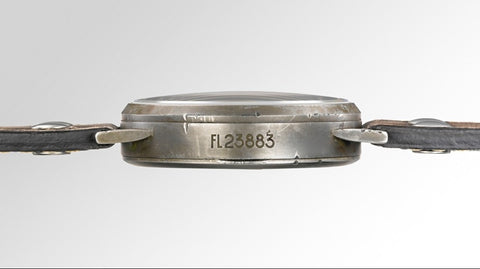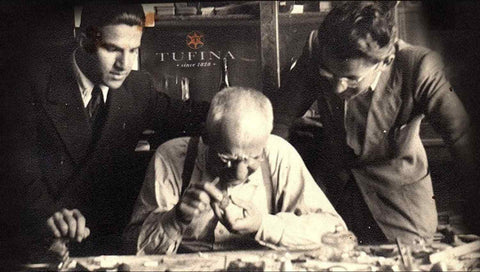Germany has established a strong reputation for beautiful engineering and functional designs. This nation, which has the fourth-biggest economy in the world, is well known for being one of the most accurate in the world, with flawless manufacturing across all industries. But it's incredible that they've been able to maintain this position and growth given everything this country has been through in the last 100 years. Like Germany's geopolitical history, the watch industry has seen ups and downs. We will discuss the history of the German watch industry in this blog article, with a particular emphasis on Pforzheim and Glashütte.

Pforzheim, Germany in 1946.
Why are the cities of Pforzheim and Glashütte important?
There was a twenty-year period in which the watchmaker industry flourished before the war started. Pforzheim and Glashütte have maintained their reputation as centers of excellence in watchmaking, earning them notoriety over the years.
Pforzheim is a name that is strongly related to the watch industry. Jean Francois Autran started constructing a watchmaking facility at an orphanage in the 1760s with the intention of assisting the children in learning practical skills and craftsmanship that would enable them to support themselves. Conversely, he aimed to introduce a novel industry to the region. The idea of developing a watchmaking business became a reality since the facility was training a steady stream of highly competent new watchmakers.
As Pforzheim's workforce began to unionize in the middle of the 19th century, new jewelry and watchmaking schools were established. Soon after, wristwatches gained enormous popularity, and the well-known companies of today started their watchmaking careers.
Numerous German watch brands were established in the 1920s. By means of their expansion and advancement, Pforzheim experienced a notable enhancement in their capacity to produce extremely accurate mechanisms. These businesses had expanded and prospered as the war drew near, hiring a significant number of highly talented watchmakers to man their workforces. With Stowa setting the standard, the Bauhaus aesthetic emerged as a significant feature of many early German timepieces.
However, even the watchmakers in Pforzheim had to pitch in after the war spread throughout the entire country. Due to facilities being repurposed for the construction of artillery, production was severely hampered, which was especially harmful to the watchmaking sector. Numerous watch companies had to create Flieger watches for the Luftwaffe in addition to fuses and torpedoes.

Vintage Flieger Watch.
The Flieger aesthetic remains one of the most influential watch styles in the industry. At the time, the functionality of these black-dialed pilot timepieces was widely acclaimed. Allied forces would undoubtedly assault the Pfozheimer because of its strategic location within the city and its significance in the creation of fuses. It took a number of years for the watchmakers in the city to recover from the 1945 onslaught. A few post-war monetary policies also assisted the watch company in raising output rates even more.
However, Glashütte also had a big impact on the development of German watchmaking. Ferdinand Adolph Lange established the city's first watchmaking establishment in 1845. Not only would his action spark a regional industrial revolution, but it would also establish his surname as one of the leading characters in the watch industry going forward. Although there was not much development in the business at the time, Lange presented the Saxon government with an initiative. He supported funding initiatives to produce watches as well as the establishment of an apprenticeship program. Soon after, the city rose to prominence as one of Germany's busiest watchmaking locations.

Ferdinand Adolph Lange - founder of the first watchmaking facility in Glashütte.
The Heritage of German Watchmaking
Made-in-Germany watches have become a trademark of high-quality watchmaking and engineering. German watch companies that uphold the heritage of German watchmaking create high-end watches that are highly regarded for a variety of features, including exquisite machining, accurate engineering, tight tolerances, remarkable stability, and elegant and sophisticated designs. German timepieces are comparable to anything else available in the market in terms of fit and quality.
All high-quality German timepieces have a number of mechanical and aesthetic characteristics. A lot of huge bridges with swan neck regulators, three-quarter or two-quarter base plates, thermally blued screws, and hand-engraved ornamentation are used. Consumers and watch aficionados from all around the world continue to seek out these design features and patterns that have been passed down through the years.

On the left Bahri Tufina | Master Watchmaker - Vintage photo of the predecessors in the Tufina family line of watchmakers.
Tufina Watches: Two Centuries in Watchmaking
Tufina proudly represents two centuries of experience in watchmaking, beginning with crafting clocks and pocket-watches to modern mechanical and automatic timepieces. Our history began in the early 1800s when Ismail Tufina traveled to Istanbul, where he was able to pick up the European trade of watchmaking from Edward Prior. One of the most notable names in the Tufina legacy, Ismail became famous for installing the mechanism of the Grand Clock Tower in Tirana. He passed his craft and knowledge to his children and grandchildren, a tradition which would later become the core of our brand’s foundation. Throughout the years, our family operated as an independent business, often forging partnerships with other successful brands and companies in Europe.
Despite facing the turmoil of political upheavals, and even the unfortunate loss of family members during the oppressive regime in Albania, we managed to preserve our practice. The 90s marked another era, when Enis Tufina established our brand’s headquarters in Germany. In 2004, our two representative collections - Theorema and Pionier - were released and licensed in Munich. We take great pride in providing watches that are expertly and precisely made. Our skilled watchmakers have refined their skills and expertise to deliver hand-assembled German watches of outstanding quality. From fancy tourbillons to high-precision chronographs, our collections feature timeless designs and impressive features. Utility combined with style and durability, our timepieces offer the best of German craftsmanship at reasonable prices.







Leave a comment